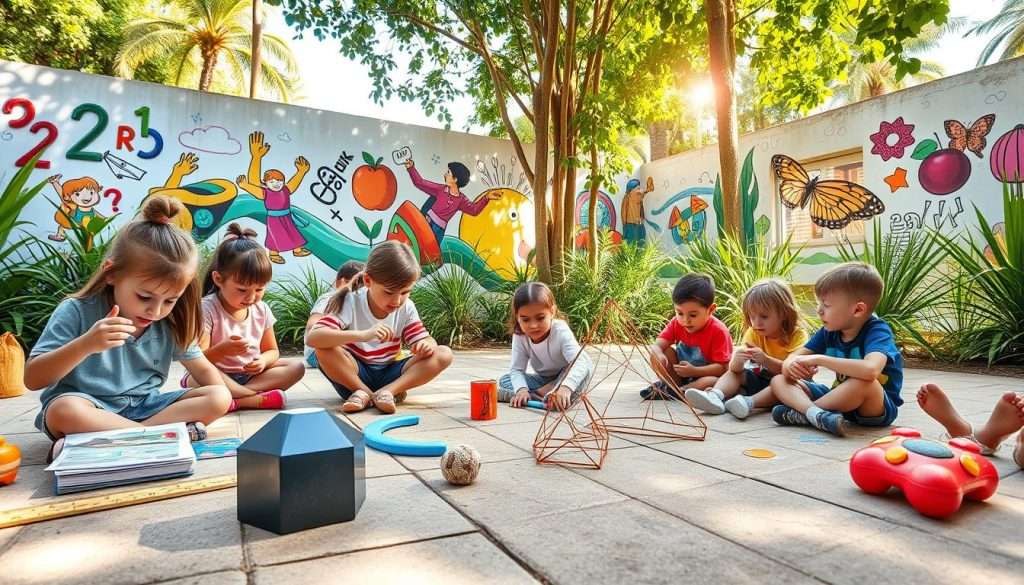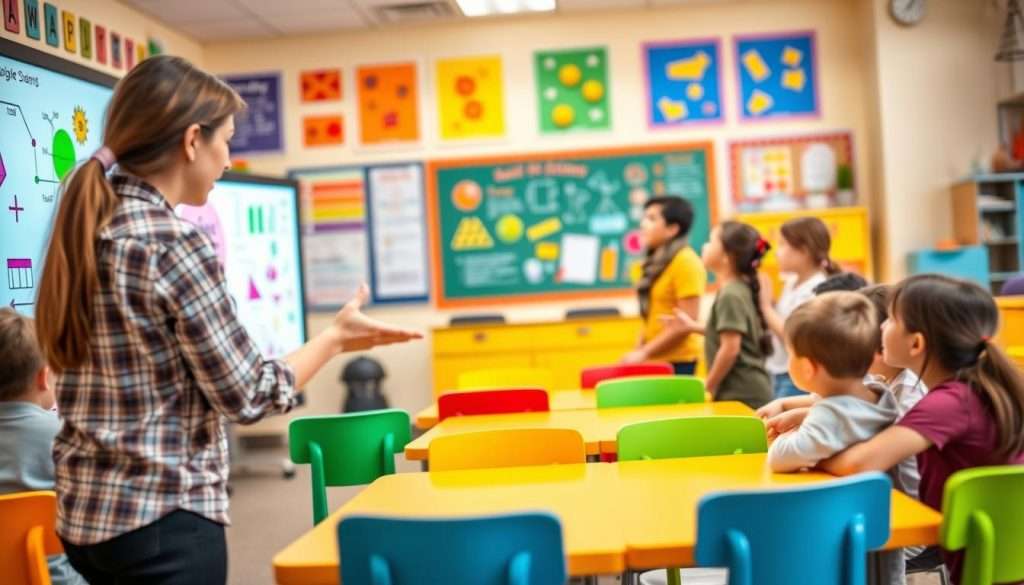Are you tired of seeing your kids struggle with math, their faces scrunching up in frustration? We believe that learning should be fun. And when it comes to math, it’s no exception. By using engaging math lessons and interactive math activities, we can turn studying into playtime.
Research shows that when kids enjoy learning, they do better. So, how can we make math fun for our kids? By introducing interactive math activities that challenge and engage them, we can help them see math in a positive light.
Key Takeaways
- Engaging math lessons can improve kids’ performance.
- Interactive math activities make learning fun.
- Making math enjoyable creates a positive association.
- Personalized learning experiences boost kids’ confidence.
- Math games and puzzles are great interactive tools.
Why Children Often Struggle with Math
Many kids find math hard, but knowing why helps us find ways to help. Math anxiety is a big problem. It comes from how math is taught and the pressure to do well.
Common Math Anxiety Triggers
One big reason is the old way of teaching math. It often just makes kids memorize, not really understand. As Boaler (2015) says, “the way we teach math can either open doors or close them for students.” We can make math fun by using math games and fun math resources.
The Impact of Traditional Teaching Methods
Old teaching methods make math seem boring. But, using educational math tools can make it more fun.
Breaking Down Math Barriers
To beat math anxiety, we must break down these barriers. By adding interactive and engaging math activities, we can help kids see math in a better light. As
“Math is not just about numbers, it’s about problem-solving and critical thinking.”
The Psychology Behind Making Math Fun
Making math fun is more than just entertainment. It’s based on psychological principles that boost learning. By adding engaging math lessons and fun challenges, we make math more enjoyable. This also helps kids learn and remember math better.
How Enjoyment Enhances Learning
Enjoyment is key in learning. When kids have fun, they focus better. This makes them better at learning and remembering things.
Studies show that feeling good while learning helps keep information in our minds longer.
Building Confidence Through Positive Experiences
Good experiences with math can really boost a child’s confidence. Fun and challenging math activities help kids feel they can do it. This confidence can help them in other school subjects too.
Creating Math-Positive Mindsets
By making math fun, we help kids see math in a positive light. We move from just solving problems to exploring the cool side of math. When math seems fun and interesting, kids are more excited to learn it.
Everyday Opportunities to Make Math Fun
Everyday tasks are full of chances to make math fun for kids. By adding math to our daily routines, we can turn learning into a fun adventure.
Kitchen Math Adventures
The kitchen is a perfect spot to start making math exciting. Cooking and baking offer many exciting math exercises that kids love.
Measuring and Fraction Activities
Measuring ingredients for a recipe is a great way to introduce fractions. You can have your kids measure with different units like cups, tablespoons, or teaspoons.
Cooking Time Calculations
Cooking time involves understanding time, temperature, and sequencing. You can challenge your kids to figure out cooking times based on different factors.
Shopping Expeditions as Math Lessons
Shopping trips can become fun math resources by getting kids involved. They can compare prices, calculate totals, and make change.
Turning Chores into Math Games
Household chores can become math games by adding measurement, counting, and time estimation. For instance, you can ask kids to measure the area to clean or guess how long a task will take.
Playful Math Activities for Preschoolers (Ages 3-5)
We can make math fun for preschoolers by adding it to their play. At this age, kids are naturally curious. Their play is full of chances to learn math.
By making everyday moments math lessons, we can help them love math early on.
Counting Games with Household Items
Counting games are a great way to introduce math to preschoolers. You can use toys, blocks, or fruit for simple counting. For example, count the apples on the kitchen table or the toy cars in a row.
This activity teaches counting and helps with fine motor skills as they move objects.
Shape Recognition Activities
Teaching shape recognition through play is key. Use everyday objects to show different shapes. For example, a clock is a circle, a book is a rectangle, and a pyramid is a triangle.
You can also use shape sorters or puzzles to make learning fun.
Simple Pattern Building Exercises
Pattern building is a great way to introduce sequences and predictions. You can use different attributes like color or size to create patterns.
Color Patterns
Make a color sequence with blocks, toys, or colored cards. For example, red, blue, red, blue. Ask your child to continue the pattern. This activity helps them recognize and predict sequences.
Size Sequencing
Use objects of different sizes to create a sequence. For example, small, medium, large, small, medium, large. Use cups, blocks, or other objects that vary in size. This activity helps them understand size and order.
| Activity | Math Concept | Age Group |
|---|---|---|
| Counting Games | Counting, Basic Addition | 3-5 years |
| Shape Sorting | Shape Recognition | 3-5 years |
| Pattern Building | Sequences, Predictions | 3-5 years |
Engaging Math Games for Elementary Students (Ages 6-10)
Math doesn’t have to be boring. Here are some fun math games for kids aged 6-10. At this age, kids are learning basic math skills. Interactive games can help them love learning math.
Multiplication and Division Card Games
Card games are great for practicing math facts. Kids can play “Multiplication War” or “Division Snap” with a deck of cards. These games boost math skills and strategic thinking. You can make your own rules or follow existing ones for more fun.
Fraction Fun with Food
Teaching fractions with food is tasty and fun. Cut a pizza or cake into parts to show fractions. For example, taking 2 slices of an 8-slice pizza is 1/4. This hands-on method makes fractions relatable and enjoyable.
Measurement Scavenger Hunts
Measurement scavenger hunts are fun and educational. Kids measure items around the house or backyard. This activity is great for different ages and skill levels, making math engaging.
Length and Distance Challenges
For length and distance, give kids a ruler or tape measure. Ask them to measure objects. They can compare lengths in a table. This helps them understand measurement units.
Weight and Volume Explorations
Use a kitchen scale and containers for weight and volume. Kids can compare weights and learn about units like grams and milliliters. This hands-on activity is an entertaining math challenge.
| Activity | Math Concept | Age Group |
|---|---|---|
| Multiplication War | Multiplication Facts | 6-8 years |
| Fraction Pizza | Fractions | 7-10 years |
| Measurement Scavenger Hunt | Measurement | 6-10 years |
By adding these engaging math lessons and fun resources to your child’s routine, you can help them see math positively. The goal is to make math fun and interactive. This way, kids stay engaged and motivated.
Creative Math Challenges for Middle Schoolers (Ages 11-13)
As middle schoolers explore math, it’s key to offer challenges that spark creativity and problem-solving. At this age, they’re honing their critical thinking. Engaging math exercises can greatly impact their learning.
Real-World Problem Solving Projects
Real-world problem-solving projects make math exciting. Students can design a mock city, figuring out costs, areas, and resource use. This innovative math learning shows them how math applies in real life.
- Design a sustainable community garden, considering space, cost, and resource management.
- Create a budget plan for a school event, incorporating revenue projections and expense management.
Geometry Through Art and Design
Geometry becomes more fun when mixed with art and design. Students can dive into exciting math exercises by making geometric patterns, tessellations, or architectural designs. This method not only teaches geometry but also boosts creativity.

Budget Planning Activities
Budget planning is a vital skill that math can teach. Through educational math tools like budgeting games or simulations, students learn to manage money well.
Creating a Mock Business
Students can start a mock business, setting prices, managing expenses, and figuring out profits. This hands-on learning teaches them the value of money and the need for financial planning.
Personal Savings Goals
Setting personal savings goals makes math relevant. Students can figure out how much to save for a goal, learning about saving and budgeting.
- Determine the savings goal.
- Calculate the amount needed to save each week or month.
- Track progress and adjust the plan as necessary.
By adding these creative math challenges, we can make math fun and relevant for middle schoolers. This prepares them for success in their future studies and careers.
10 Ways to Make Math Fun with Technology
Technology can make math fun for young learners. It offers many interactive activities that capture kids’ attention. Learning math becomes a fun experience.
Educational Math Apps Worth Downloading
Many educational math apps are out there. Apps like Math Playground and Khan Academy Kids have games and activities for all ages. They use cool visuals and rewards to keep kids excited about math.
Online Math Games That Actually Teach
Online math games are also great. Sites like Coolmath and Math Goodies have games that teach math concepts. These games are both fun and educational, helping kids learn math while having fun.
Coding as a Math Learning Tool
Coding is a fun way to learn math. Platforms like Scratch and Code.org teach coding with math. Kids learn to solve problems and think logically, gaining a deeper math understanding.
Technology makes math learning more engaging and effective. Apps, online games, and coding offer many ways to make math fun and accessible.
Outdoor Math Activities for Active Learning
Math becomes exciting when you take it outside. Nature and playgrounds offer innovative math learning experiences. You can turn everyday objects and environments into fun math lessons.
Playground Geometry
The playground is a geometric wonderland. It’s perfect for learning about shapes. You can find circles, triangles, and rectangles on the playground.
- Measure the diameter of a merry-go-round and calculate its circumference.
- Use the monkey bars to demonstrate the concept of parallel lines and angles.
- Identify symmetrical shapes in playground equipment.
Nature-Based Counting and Patterns
Nature is full of materials for exciting math exercises. You can count leaves or create patterns with natural objects. Collect items like pinecones, sticks, and rocks for math activities.
Here are some ideas to get you started:
- Collect different types of leaves and count them to practice basic arithmetic operations like addition and subtraction.
- Create patterns using natural objects, such as alternating between pinecones and acorns.
- Measure the length of various sticks to understand units of measurement.

Physical Games That Reinforce Math Concepts
Physical games are great for reinforcing math concepts. They also promote physical activity. You can add math elements to traditional games, making them more engaging math lessons.
Some examples include:
- Playing “Math Tag” where players have to solve a math problem to avoid being “it.”
- Creating a “Math Scavenger Hunt” that requires kids to find and solve math problems related to objects they find outdoors.
- Using hopscotch to practice number sequences and basic arithmetic.
By adding these outdoor math activities to your child’s routine, math becomes fun. So, get outside and explore math together!
Math Through Arts and Crafts
Math isn’t just about numbers. It’s also about patterns, shapes, and creativity. We can explore these through arts and crafts. This way, we can make fun math resources that kids will enjoy.
Geometric Art Projects
Geometric art projects are great for teaching math. They cover shapes, symmetry, and geometry. For example, making art with shapes helps kids learn about their properties.
Origami and Paper Folding
Origami teaches geometry and spatial reasoning. Kids learn about angles, shapes, and dimensions by folding paper.
Symmetry in Art
Creating symmetrical art projects teaches kids about symmetry and reflection. They can do this by folding paper and cutting out shapes for symmetrical designs.
Music and Math Connections
Music is closely tied to math. Teaching kids about rhythm, beats, and patterns through music boosts their math skills. It helps them understand fractions and ratios better.
Storytelling with Numbers
Storytelling is a creative way to add math to stories. It makes math more relatable and interesting. By using numbers in stories, kids practice math while using their imagination.
Building a Math-Positive Home Environment
Turning our homes into math-friendly spaces can make math exciting for our kids. We can create an environment that encourages exploration and celebrates math achievements. This helps our children see math as an adventure.
Creating a Math Resource Corner
Setting up a “Math Resource Corner” in our homes can make math more fun and accessible. This area can have interactive math activities like puzzles, games, and books. Having these resources nearby encourages kids to explore math at their own pace.
Modeling Positive Math Attitudes
As parents, we shape our children’s views on math. Showing a positive attitude towards math shows our kids it’s fun and valuable. Sharing how we use math in daily life makes it more interesting.
“Math is not just about numbers; it’s about problem-solving and critical thinking.”
Celebrating Math Achievements
Celebrating our children’s math wins is key to boosting their confidence. We can use a “Math Achievement Chart” on the fridge or a special wall. Each milestone achieved gets a sticker or note, showing progress and motivating them to keep learning.
By using these strategies, we can make our homes supportive and fun for math learning. Let’s turn our homes into vibrant math-positive spaces for our kids!
Conclusion: Transforming Math from Dreadful to Delightful
We’ve looked at many ways to make math fun for kids. From kitchen math to outdoor games and tech tools, we’ve got it all. By adding math games, fun math resources, and exciting math exercises to their day, we can make math a positive part of their lives.
It’s not just about the fun activities. It’s about creating a space where kids feel free to learn and explore. By showing them how much we value math and celebrating their wins, we boost their confidence. This helps them develop a lifelong love for math.
So, let’s start making math fun for our kids! Try out some of the ideas we’ve shared. Watch as math becomes a joyful part of their lives. With a little patience, creativity, and the right tools, we can make math exciting for every child.

